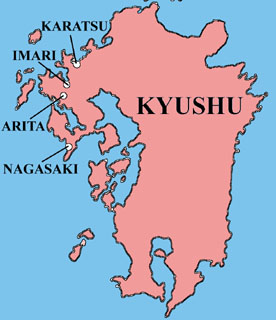 There
was no porcelain production in Japan at the beginning of the 17th century.
The Japanese had had a long experience of stoneware manufacture for the
domestic market and in particular for the tea ceremony but for some reason
had not produced porcelain despite the fact that Chinese porcelain was highly
prized in Japan. The advent of porcelain production in Japan is laced with
many apocryphal stories. But, probably as a result unsuccessful military
excursions into Korea in the 1590's, Korean potters were brought to Japan
and settled in the island of Kyushu (the nearest Japanese island to Korea,
where they first landed) and revived a stoneware pottery in Karatsu. At
first the potters made stoneware pots in the Korean mode. The Korean potters
also brought with them the technology to build the more sophisticated noborigama
climbing kiln. Some time within the first ten years of the 17th century
a large deposit of porcelain stone was discovered in the mountainside of
Mount Izumiyama close to the town of Arita. At first, both porcelain and
stoneware were produced in parallel but later porcelain kilns arose in areas
around Arita where running water was available for the driving of mechanical
stone crushers to process the porcelain stone and the levigation of the
porcelain clay. For these reasons, Arita became the main centre for porcelain
production in Japan. There
was no porcelain production in Japan at the beginning of the 17th century.
The Japanese had had a long experience of stoneware manufacture for the
domestic market and in particular for the tea ceremony but for some reason
had not produced porcelain despite the fact that Chinese porcelain was highly
prized in Japan. The advent of porcelain production in Japan is laced with
many apocryphal stories. But, probably as a result unsuccessful military
excursions into Korea in the 1590's, Korean potters were brought to Japan
and settled in the island of Kyushu (the nearest Japanese island to Korea,
where they first landed) and revived a stoneware pottery in Karatsu. At
first the potters made stoneware pots in the Korean mode. The Korean potters
also brought with them the technology to build the more sophisticated noborigama
climbing kiln. Some time within the first ten years of the 17th century
a large deposit of porcelain stone was discovered in the mountainside of
Mount Izumiyama close to the town of Arita. At first, both porcelain and
stoneware were produced in parallel but later porcelain kilns arose in areas
around Arita where running water was available for the driving of mechanical
stone crushers to process the porcelain stone and the levigation of the
porcelain clay. For these reasons, Arita became the main centre for porcelain
production in Japan.
By the 1640's
the Arita kilns were producing blue and white porcelain (which the Japanese
call ko-sometsuki) and celadon ware. In addition, Japanese potters
had started to use overglaze enamel decoration in the 1630's. There was
a wide variation in the shapes and styles of decoration. Saggars were
being used to protect the pottery in the kilns and kiln temperature control
was improved. Much high quality and freely artistic ware in Japanese style,
the shoki-Imari ware, was produced in this pre-export period. By the 1650's
the technology and skill base was able to cope with the demands of an
export trade.
|


